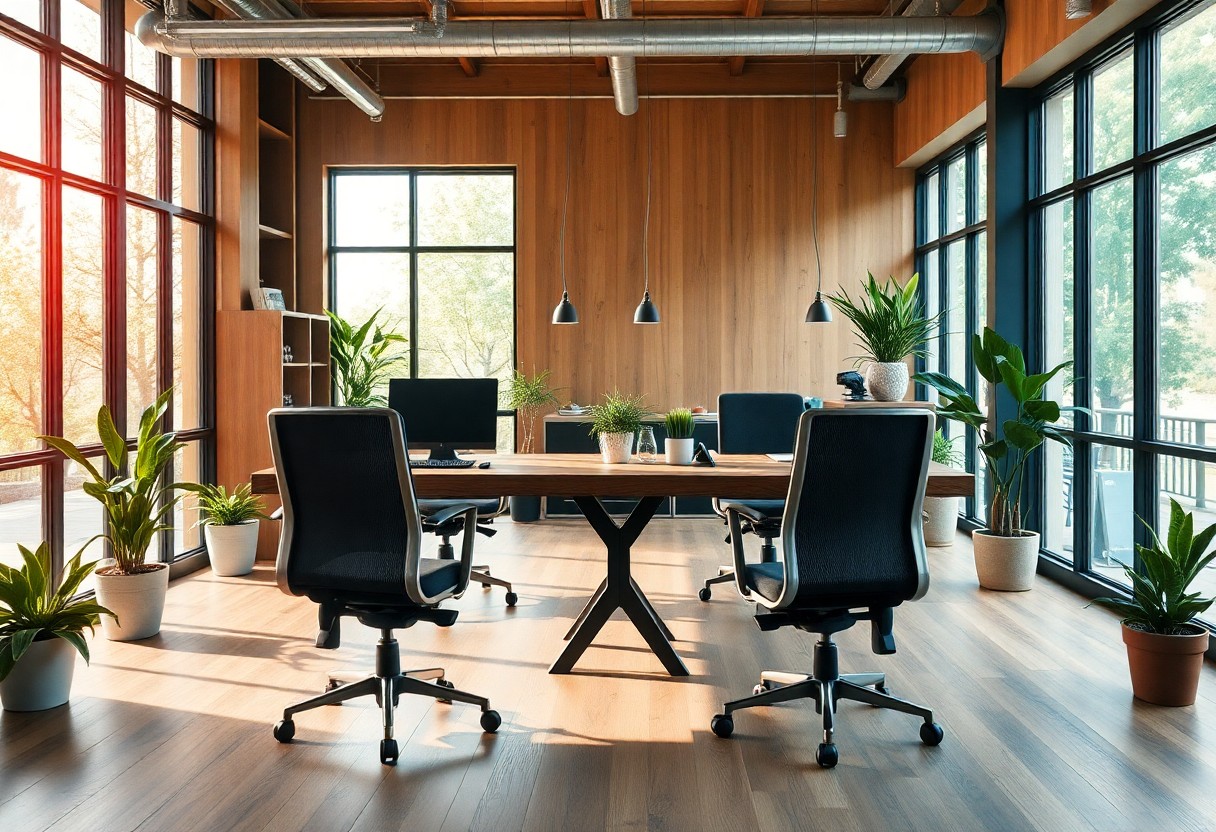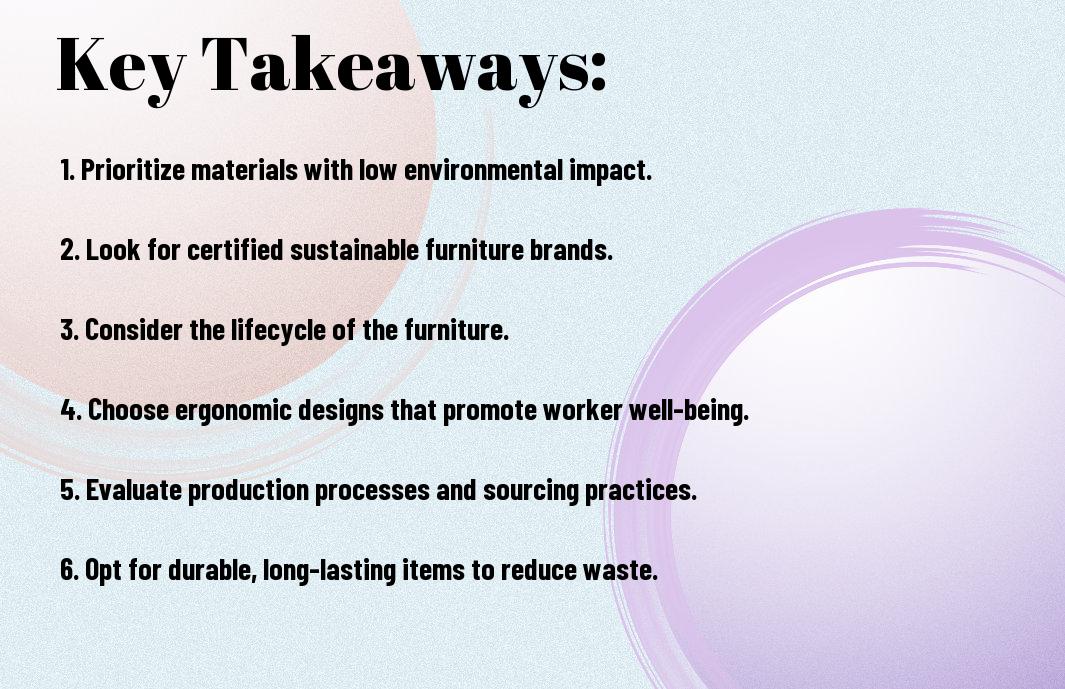You’re considering renovating your office, and your choice of furniture will have a significant impact on the environment. As you weigh your options, you’ll want to prioritize sustainability to minimize your ecological footprint. Your decision will not only affect the planet, but also contribute to a healthier workspace. You’ll need to evaluate materials, production processes, and durability to make an informed choice that aligns with your values and supports a more environmentally conscious workplace.

Key Takeaways:
To select sustainable office furniture, consider the following points:
- Look for furniture made from recycled materials or reclaimed wood to reduce waste and support eco-friendly practices.
- Choose furniture with energy-efficient designs, such as chairs with adjustable ergonomics to promote comfort and reduce the need for frequent replacements.
- Consider the lifespan of the furniture and opt for pieces with durable construction and easy maintenance to minimize waste and support a circular economy.

Defining Sustainable Office Furniture
A key aspect of creating an environmentally friendly workspace is selecting furniture that aligns with your values. You want your office furniture to be made from materials that do not harm the environment and are designed to last, reducing waste and the need for frequent replacements.
Importance of Eco-Friendly Materials
To determine the sustainability of your office furniture, you need to consider the materials used in its construction. You should opt for materials that are recycled, recyclable, or sustainably sourced, as these have a lower environmental impact.
Certifications and Labels to Look For
Certifications such as FSC and Greenguard can help you identify sustainable office furniture. You can look for these labels when shopping for furniture to ensure that your choices align with your environmental goals.
The certifications and labels you find on sustainable office furniture are not just marketing tools, but rather a guarantee that the product has met certain standards. You can use these labels to make informed decisions about your purchases, and be confident that you are buying furniture that is better for the environment. As you shop for your office furniture, you should prioritize products with these certifications to create a workspace that is both functional and sustainable.
Assessing Your Office Needs
Some offices have specific requirements that need to be met when choosing sustainable furniture. You should consider the overall aesthetic and functionality you want to achieve in your workspace.
Workspace Requirements and Budget
Office layouts and dimensions play a significant role in determining the type of furniture you can accommodate, and your budget will also influence your decision.
Employee Comfort and Productivity
Around the office, you’ll notice that employee comfort and productivity are closely linked to the furniture they use, and you should prioritize their needs when making your selection.
Another aspect to consider is the long-term benefits of investing in ergonomic furniture, which can lead to increased job satisfaction and reduced absenteeism, ultimately benefiting your business and contributing to a more sustainable work environment.
Furniture Options and Alternatives
After considering your office needs, you can explore various sustainable furniture options, from eco-friendly materials to refurbished pieces, to create a workspace that aligns with your values.
Repurposed and Refurbished Furniture
Furniture remnants can be transformed into unique and functional pieces, allowing you to reduce waste and give old items a new life, making your office furniture selection more sustainable.
Innovative Materials and Designs
Behind the scenes, manufacturers are developing innovative materials and designs that prioritize sustainability, enabling you to choose furniture that not only reduces environmental impact but also enhances your workspace aesthetic.
Even as you explore deeper into innovative materials and designs, you will find that your options expand to include furniture made from recycled plastic, bamboo, and other sustainable resources, allowing you to create a truly eco-friendly office environment that reflects your commitment to reducing your environmental footprint.
Evaluating the Environmental Impact
To make informed decisions, you need to assess the environmental effects of your choices. Consider the materials, production processes, and disposal methods of the furniture you select.
Carbon Footprint and Energy Efficiency
Evaluating the carbon footprint of your office furniture is important. You should look for products with low energy consumption and sustainable materials to minimize your impact on the environment.
Waste Reduction and Recycling
Beside the energy efficiency, you should also consider waste reduction and recycling options. You can choose furniture made from recycled materials or designed for easy recycling.
Another aspect of waste reduction is the durability of the furniture. You can opt for high-quality, long-lasting pieces that will not need to be replaced often, reducing the amount of waste generated by your office. By doing so, you will contribute to a more sustainable environment and reduce your ecological footprint.
Creating a Sustainable Office Space
All aspects of your office space contribute to its sustainability. You’ll want to consider the environmental impact of your furniture, layout, and systems. By making informed choices, you can reduce your office’s carbon footprint and create a healthier workspace.
Layout and Design Considerations
One key factor in designing a sustainable office is the layout. You should arrange your space to maximize natural light and minimize waste. Consider the flow of traffic and the placement of furniture to create an efficient and comfortable workspace.
Lighting and Ventilation Systems
Creating a sustainable office space also involves installing efficient lighting and ventilation systems. You can invest in LED bulbs and solar-powered systems to reduce energy consumption. Proper ventilation is also important for maintaining good air quality and reducing the need for air conditioning.
In fact, a well-designed lighting and ventilation system can significantly reduce your energy costs and improve the overall health and productivity of your employees. You can consider installing occupancy sensors, which automatically turn off lights when a room is unoccupied, and use natural ventilation techniques, such as opening windows, to reduce the need for mechanical systems.
Implementation and Maintenance
Not only is choosing sustainable office furniture important, but implementing and maintaining it is also vital to reducing your environmental impact. You must consider the entire lifecycle of your furniture to ensure sustainability.
Procurement and Installation Process
Besides the initial selection, you should also consider the procurement and installation process, ensuring that your sustainable furniture is delivered and set up in a way that minimizes waste and carbon emissions, allowing you to make a positive impact on the environment.
Ongoing Care and Upkeep
By adopting a proactive approach to maintenance, you can extend the life of your sustainable furniture, reducing the need for frequent replacements and the waste that comes with it, which will help you to achieve your sustainability goals.
In addition, to properly care for your sustainable office furniture, you should establish a regular cleaning schedule, address any repairs promptly, and consider repurposing or repainting items when possible, which will help you get the most out of your investment and support your commitment to sustainability.
Final Words
Following this guide, you can make informed decisions when selecting sustainable office furniture. You will be able to evaluate your needs, consider eco-friendly materials, and choose pieces that promote a healthy work environment. By doing so, you will not only reduce your environmental impact but also create a space that benefits your well-being and productivity. Your thoughtful choices will contribute to a more sustainable future, and you can take pride in your role in protecting the planet.
FAQ
Q: What are the key factors to consider when choosing sustainable office furniture?
A: When dicking out sustainable office furniture, consider the materials used, such as recycled or sustainably sourced wood, and the production process. Look for certifications like FSC (Forest Stewardship Council) or Greenguard Gold, which ensure the furniture meets certain environmental standards. Additionally, think about the durability and longevity of the piece, as well as its ability to be recycled or repurposed at the end of its life cycle.
Q: How can I determine the environmental impact of a piece of office furniture?
A: To assess the environmental impact of office furniture, examine the materials, manufacturing process, and transportation methods used. Check if the manufacturer provides information on the carbon footprint, waste reduction, and energy efficiency of their products. You can also look for environmental product declarations (EPDs) or life cycle assessments (LCAs) that provide a comprehensive overview of the furniture’s environmental effects.
Q: What are some eco-friendly materials used in sustainable office furniture?
A: Sustainable office furniture often incorporates eco-friendly materials such as reclaimed or recycled wood, bamboo, and low-VOC (volatile organic compound) finishes. Some manufacturers also use innovative materials like recycled plastic, bioplastics, or plant-based composites. Furthermore, consider furniture with natural textiles, such as organic cotton or hemp, and avoid products with chemicals like formaldehyde, flame retardants, or stain-resistant treatments.
Q: Can sustainable office furniture be budget-friendly?
A: While sustainable office furniture may have a higher upfront cost, it can be a cost-effective option in the long run. Durable, well-made furniture can last longer, reducing the need for frequent replacements and waste. Additionally, energy-efficient furniture with features like LED lighting or ergonomic design can lead to increased productivity and reduced energy consumption, resulting in cost savings over time. Consider the total cost of ownership, including maintenance, repair, and end-of-life disposal, to make an informed decision.
Q: How can I ensure that my sustainable office furniture is also functional and comfortable for employees?
A: To balance sustainability with functionality and comfort, involve your employees in the decision-making process and conduct a needs assessment to determine the required features and specifications. Choose furniture that promotes ergonomics, flexibility, and well-being, such as adjustable desks, comfortable seating, and adequate lighting. Consider the acoustic and visual comfort of the space, and select furniture that aligns with your company’s culture and brand identity. By prioritizing both sustainability and user experience, you can create a workspace that supports the health, happiness, and productivity of your employees.
